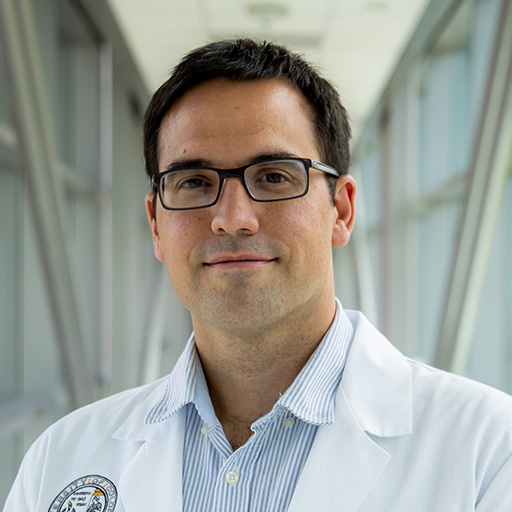Transgenic Mice With Increased Expression of VEGF in RPE Cells
Principal Investigator
Peter Campochiaro, MD
Johns Hopkins University School of Medicine
Baltimore, MD, USA
About the Research Project
Program
Award Type
Standard
Award Amount
$37,500
Active Dates
April 01, 2000 - March 31, 2001
Grant ID
M2000027
Goals
Vascular Endothelial Cell Growth Factor (VEGF) is a powerful growth factor that induces neovascularization (the formation of new blood vessels) beneath the eye’s retina. Because choroidal neovascularization (CNV) occurs in age-related macular degeneration, several researchers have been interested in the possible causative role of VEGF. Dr. Campochiaro has succeeded in creating a transgenic breed of mouse that expresses VEGF in photoreceptors. Although VEGF is produced in proximity to the choroid (a layer of cells just beneath the retina where neovascularization occurs in humans), CNV does not occur in mice. Dr. Campochiaro hypothesizes that the retinal pigmented epithelial (RPE) cells prevent the VEGF from reaching the choroidal layer. In this continuation of last year’s study, he is now testing this hypothesis by producing another transgenic mouse that produces VEGF in RPE cells in order to determine if they develop CNV. If they do, these mice will be important tools in studying CNV and for testing new therapies to halt or prevent neovascularization.
Summary
Patients with age-related macular degeneration (AMD) experience slow loss of their center vision because of gradual death of retinal cells that are needed for vision. This gradual death of cells constitutes the degeneration component of the disease and as it occurs, there is a tendency for abnormal blood vessels to grow from the choroid into the retina where they leak and bleed and cause rapid and severe loss of vision. In fact, abnormal blood vessel growth is the major cause of severe vision loss in patients with AMD. Current treatments such as laser photocoagulation and submacular surgery are directed at eliminating the abnormal blood vessels, but do nothing to treat the underlying cause of blood vessel growth, and therefore even when these treatments are initially successful, the blood vessels usually come back and destroy vision. New treatments are needed to find the cause of abnormal blood vessel growth so that new treatments can be developed.
Hypothesis
Our hypothesis is that as degeneration occurs in patients with AMD, one type of retinal cell, retinal pigmented epithelial (RPE) cells, becomes sick and begins to produce a stimulus for blood vessel growth called vascular endothelial growth factor (VEGF). To test this hypothesis, we plan to make genetically engineered mice that produce high levels of VEGF in their RPE cells. If our hypothesis is correct, these mice will get abnormal blood vessel growth like that seen in patients with AMD.
Specific Aims
Specific Aim I is to make genetically engineered mice that will produce high levels of VEGF in their RPE cells when they are given a particular antibiotic. This is possible because of a newly devised inducible promoter system that responds to the antibiotic. Specific Aim 2 is to determine how much VEGF these mice produce in their RPE cells when the mice are given various amounts of the antibiotic either by mouth or by injection. This will allow us to choose the appropriate amount of antibiotic and the best way to give it for the experiments in Aims 3 and 4. Specific Aim 3 is to treat relatively young mice with antibiotic in such a way that a moderate or high level of VEGF is produced in their RPE cells and then determine if there is abnormal blood vessel growth like that seen in patients with AMD. Older mice will be treated in the same way to determine if there is any difference from the younger mice. If abnormal blood vessel growth occurs as expected in the experiments in Aim 3, then specific Aim 4 will test if by withdrawing the antibiotic, and thereby decreasing the production of VEGF in RPE cells to a normal level, the abnormal blood vessels go away. If the blood vessels do go away, this will suggest that drugs that block the effects of VEGF may help patients with AMD get rid of abnormal blood vessels.
Long-Term Goals
The ultimate goal of this project is to develop new treatments that prevent abnormal blood vessels from growing in the retinas of patients with AMD and cause already established abnormal blood vessels to go away. The first step leading to this goal is to determine if excessive production of VEGF in RPE cells can cause abnormal blood vessel growth like that seen in patients with AMD. This question will be answered by the genetically engineered mice that we generate and if these mice do get abnormal blood vessel growth, they will be a valuable animal model that could be used to test new treatments. The first test will be to determine if by withdrawing the antibiotic and allowing the VEGF production to return to normal in RPE cells, the abnormal blood vessels in the retina go away. If they do, then drugs that block the effects of VEGF may be useful for preventing and/or eliminating abnormal blood vessels in the retinas of patients with AMD. This could provide a new approach to prevent severe and rapid loss of vision in patients with abnormal blood vessel growth in the retina.
Grants
Related Grants
Macular Degeneration Research
Understanding Early Molecular Events in Age-Related Macular Degeneration
Active Dates
July 01, 2024 - June 30, 2026

Principal Investigator
Sandeep Moothedath Subrahmanian, PhD
Current Organization
Pennsylvania State University College of Medicine
Macular Degeneration Research
Exosomes and Autophagy: Suspicious Partners in Drusen Biogenesis and AMD
Active Dates
July 01, 2024 - June 30, 2027

Principal Investigator
Miguel Flores Bellver, PhD
Current Organization
University of Colorado Anschutz Medical Campus
Macular Degeneration Research
Innovative Night Vision Tests for Age-Related Macular Degeneration
Active Dates
July 01, 2024 - June 30, 2027

Principal Investigator
Maximilian Pfau, MD
Current Organization
Institute of Molecular and Clinical Ophthalmology Basel (Switzerland)



